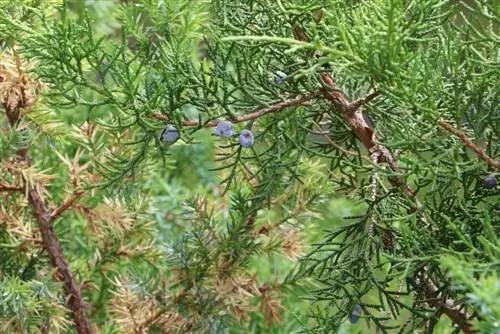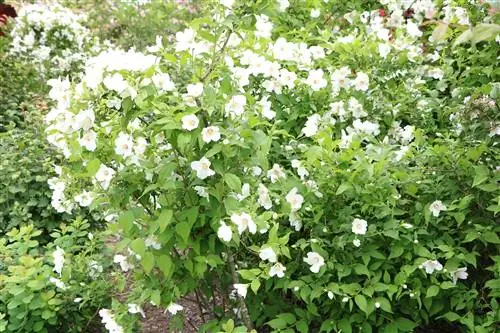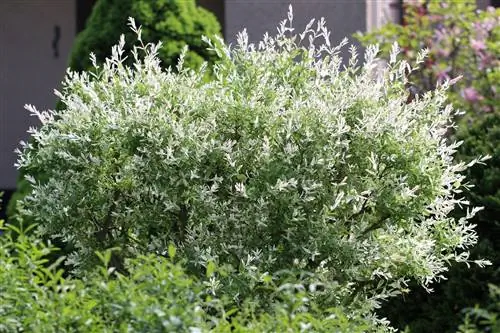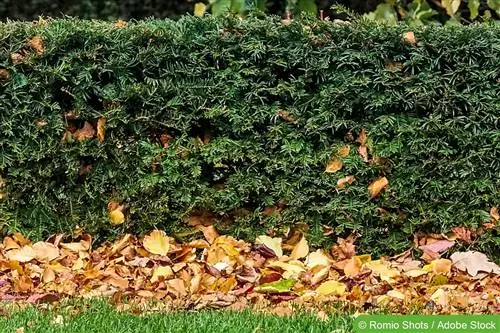- Author admin [email protected].
- Public 2023-12-17 03:39.
- Last modified 2025-01-24 12:45.
Creative hobby gardeners know how to use the multifaceted talents of a juniper creatively. As an opaque, evergreen hedge, the conifer fulfills its task just as reliably as it does as an imaginative bonsai or majestic solitaire. The pivotal point in the professional care protocol is skillful shape and maintenance pruning. In order to prune a juniper properly, a few essential guidelines are required. The following lines explain what these are and how they are handled artfully.
Time
Juniper has an extremely robust constitution. Regardless of whether it is cultivated in the garden as a shrub, tree, bonsai or hedge, it tolerates frosty cold as well as sweltering heat without complaint. This flexibility continues with regard to choosing the optimal time for pruning.
- Juniper tolerates pruning throughout the entire growing season
- Ideal dates are in spring before budding and autumn from August to October
- On the deadline there will be frost-free weather, without rain or bright sunshine
Preparation
When inexperienced home gardeners prune a juniper, they are faced with an unexpected challenge. The vast majority of all species and varieties are densely covered with strong needles. If you expose yourself to these unprotected, you risk unpleasant injuries. To make matters worse, the cypress plant has a slight toxic content, which can trigger an allergic reaction in susceptible people. So equip yourself in advance as follows:
- Long sleeve top and long pants
- Robust gardening gloves
- Sturdy shoes
- Eye protection
In addition, the cutting tool should be freshly sharpened and disinfected with high-percentage alcohol.
Cutting as a hedge

In view of juniper's slow growth rate, a single cut per year in spring is sufficient to ensure a well-groomed appearance as a hedge. Done regularly, fresh, young shoots are encouraged in order to avoid the aging process. In addition, you specifically counteract unwanted baldness from the inside out. Here's how to do it:
- The aim is to have a trapezoidal shape so that light and air reach all regions of the hedge
- Stretched cords or a wooden frame serve as orientation
- In the first step, cut out all dead shoots
- Cut off stunted, diseased branches and inwardly growing branches at the base
- For the topiary, move the hedge trimmer parallel to the juniper
Work your way from top to bottom, keeping an eye on the landmarks. The corners should preferably be slightly rounded, which increases the amount of incident light. If necessary, trim the juniper hedge a second time in August to enjoy its precise appearance throughout the winter.
Tip:
Before every cut, nature-loving hobby gardeners check the hedge for nesting birds or other animal inhabitants in order to postpone the date a little if necessary.
Juniper as bonsai
Juniper is often found in bonsai culture. Thanks to its compatibility with cutting, the diverse species and varieties pave the way for even inexperienced beginners to the ancient art of gardening. The cypress plant reacts flexibly and well-naturedly to all techniques, especially cutting. Regardless of the specific design goal of the bonsai gardener, the following general premises come into focus:
- Gradual, constant pruning is preferable to drastic pruning
- Regular shoot pruning by cutting the growth tips promotes denser branching
- Uniform pruning of all shoot tips distributes the growth energy over the entire bonsai
- Pluck delicate tips with your fingers and cut strong ends
- Twigs with gray foliage or no leaves at all are thinned out
Cautious hobby gardeners prepare to remove an entire branch in order to prevent an unsightly gap. Initially, various shoots should thrive at the top and near the trunk. Only when this 'replacement' has reached a certain level of maturity is the targeted drive cut off. At least once a season, cutting a juniper as a bonsai will expand its bark. Where this develops into fibers and holes, it offers pests and fungal spores unhindered access. Using tweezers, the bark fibers are pulled off and any residue is removed with a brush.
Tip:
As an evergreen tree, juniper is recommended in bonsai art for stylish deadwood design (Jin or Shari). Before any dead wood is thinned out, this artistic variant should be considered.
Cutting specimen plants
The rich juniper genus offers wonderful species and varieties that are ideal for elegant solitaires. Although this cultivation variant offers enough space for the plant to develop freely, regular maintenance pruning is still recommended. This is especially true if a juniper is to be arranged into a creative garden sculpture. Thanks to its special compatibility with cutting, a Juniperus easily takes on an artistic form, from a harmonious ball to an elegant spiral or original animal figure. To ensure that you can enjoy your solitaire for many years to come, these basic premises for the cut are important:
- A juniper usually does not recover from radical surgery
- Regular cutting on a small scale is advantageous
- Cut off dead shoots without leaves completely
- Do not leave any stubs or ‘coat hooks’
- Ideally limit pruning to fresh shoots
- Make each cut at a fork in the branch
On solitary plants, such as the columnar juniper or dwarf juniper in the pot, pruning can usually be done completely free-hand. Hobby gardeners face the challenge of topiary cutting with the help of a wire template, which is available from specialist retailers in all conceivable designs. With a little craftsmanship, such a wire frame can be constructed yourself. After thinning out the juniper, small scissors serve as the ideal tool for fine cutting. After the template has been placed over the solitaire, cut off all protruding shoots up to a maximum of 1 centimeter. Pay attention to the working direction from top to bottom.
Tip:
A juniper can easily tolerate repruning every 3 to 4 weeks throughout the entire growing season from April/May to September.
Care after cutting
Although regular pruning and maintenance is of utmost importance for keeping a juniper he althy, its care is by no means limited to this aspect. Following the first cut in spring, you can promote the vitality of hedges, bonsai and solitary plants in this way:
- Water young junipers regularly and abundantly
- Let the soil dry between waterings
- Water well-established trees only when it is dry in summer
- Work mature compost into the soil once a month
- Alternatively, administer a special juniper fertilizer
In a pot, a juniper requires a little more care. Given the limited substrate volume, regular watering is mandatory, even for older specimens. In addition, wintering requires special precautions. While Juniperus do not require any special protection outdoors, in the planter there is a risk that the root ball will freeze. Therefore, wrap the bucket with bubble wrap and place it on wood, Styrofoam or an alternative, insulating material. Cover the substrate with a layer of leaves, pine needles or straw. It is important to note that if there is a clear frost, a juniper should be watered on frost-free days. If it freezes extremely while there is no moistening snow, the tree is at risk of drought stress.
Conclusion
To successfully prune a juniper, a gradual, regular approach is the top directive. If you limit the shape and maintenance pruning to the fresh shoots, this care will promote further branching and maintain the vitality of the plant. Since the time window for pruning is open throughout the entire growing season, there is no reason not to use scissors more often for a Juniperus. This premise applies equally to cultivation as a hedge, bonsai and solitary plant.






